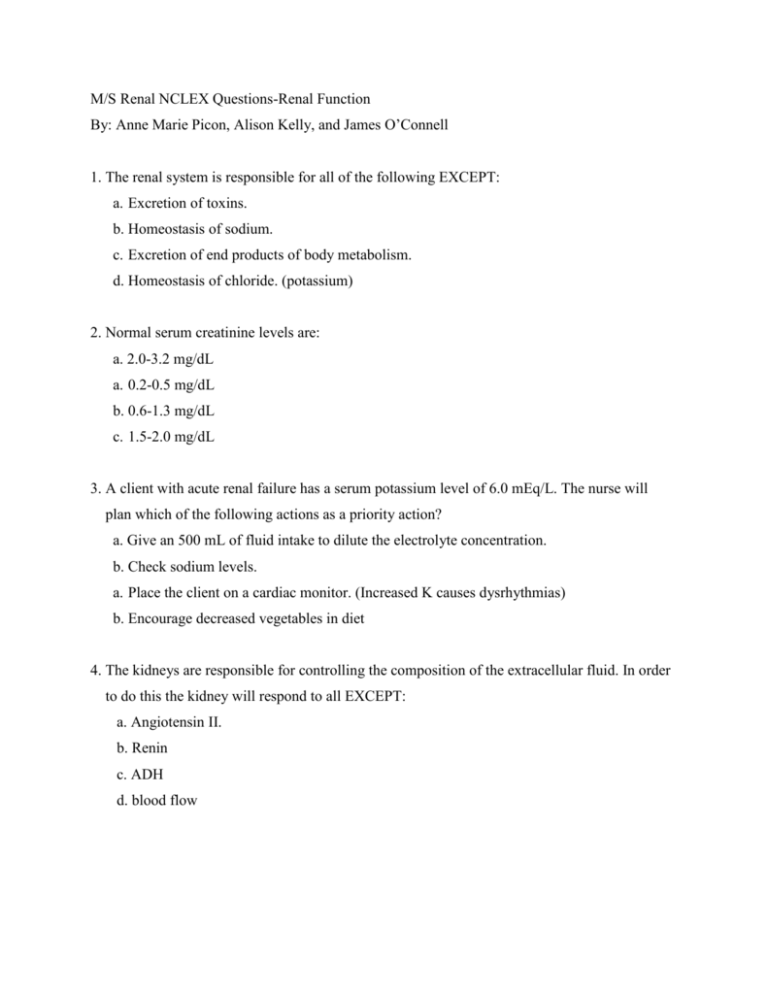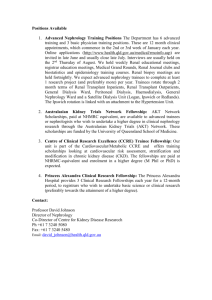Renal NCLEX Questions: Function & Pathology Review
advertisement

M/S Renal NCLEX Questions-Renal Function By: Anne Marie Picon, Alison Kelly, and James O’Connell 1. The renal system is responsible for all of the following EXCEPT: a. Excretion of toxins. b. Homeostasis of sodium. c. Excretion of end products of body metabolism. d. Homeostasis of chloride. (potassium) 2. Normal serum creatinine levels are: a. 2.0-3.2 mg/dL a. 0.2-0.5 mg/dL b. 0.6-1.3 mg/dL c. 1.5-2.0 mg/dL 3. A client with acute renal failure has a serum potassium level of 6.0 mEq/L. The nurse will plan which of the following actions as a priority action? a. Give an 500 mL of fluid intake to dilute the electrolyte concentration. b. Check sodium levels. a. Place the client on a cardiac monitor. (Increased K causes dysrhythmias) b. Encourage decreased vegetables in diet 4. The kidneys are responsible for controlling the composition of the extracellular fluid. In order to do this the kidney will respond to all EXCEPT: a. Angiotensin II. b. Renin c. ADH d. blood flow 5. Flow of fluid through the kidneys follows a strict path. Place in order the path of fluid to urine. a. Ascending loop of Henle (2) b. Distal convoluted tubule. (3) c. Collecting duct. (4) d. Glomerulus. (1) 6. A patient has severe edema and is prescribed Lasix (furosemide). Common side effects of this medication include: a. High blood pressure b. Constipation c. Dehydration d. Increased levels of sodium. By. Alison Kelly 1) A patient who has chronic renal failure is scheduled for hemodialysis this morning is due to receive a daily dose of enalapril (Vasotec). When should the nurse plan to give this medication? A. B. C. D. During Dialysis Just before Dialysis The day after Dialysis When the patient returns from Dialysis 1. Reasoning: Enalapril is an antihypertensive and these are given to patients following hemodialysis to prevent the patient from becoming hypotensive during dialysis and if it was given during dialysis the medicine could likely be removed in the blood stream by the dialysis. 2) A patient is taking cyclosporine (Sandimmune). What signs or symptoms would make you believe that the patient is having an adverse reaction? A. Nausea B. Tremors C. Alopecta D. Hypotension E. 2. Reasoning: The most common adverse reactions of cyclosporine are nephrotoxicity, infection, hypertension and tremors. So of the options listed tremors would be the correct answer. 3) Structural and functional changes occur in the kidneys as a result of the aging process. Which of the following is NOT one of the changes that kidneys undergo? A. B. C. D. Decreased bladder capacity Nocturnal polyuria occurs Kidney enlargement Decreased glomerular filtration rate 3. Reasoning: The Kidneys actually lose cortical tissue and become smaller as you age. The loss of cortical is caused by reduced renal blood flow. 4) If a patient has renal disorder which of the following lab results would most likely expect to find? A. B. C. D. A decreased hemoglobin An elevated Bun level A decreased RBC count A decreased WBC count 4. Reasoning: Measuring the BUN level is a commonly used test to determine renal function and will start to rise when the glomerular filtration rate falls below 40-60% indicating renal disorder. 5) A client who is on hemodyalis has a left arm fistula and is at risk for arterial steal syndrome. The nurse assess the patient for which of the following symptoms? A. Warmth, redness and pain in the left hand B. Pallor, diminished pulse, pain in the left hand C. Edema and a reddish discoloration on the left arm D. An aching pain, pallor, and edema of the left arm 5. Reasoning: Steal Syndrome results from vascular insufficiency after a fistula has formed and the clients begins to exhibit pallor and a diminished pulse distal to the fistula. The patient also complains of pain distal to the fistula, warmth and redness. 6) A patient newly diagnosed with renal failure has just started peritoneal dialysis. During the infusion the client complains of abdominal pain. What is the appropriate action by the nurse? A. Stop the dialysis B. Slow the infusion rate C. Decrease the amount to be infused D. Explain that the pain will subside after the first few exchanges 6. Reasoning: Pain during the inflow portion of dialysis is common during the first few exchanges because of peritoneal irritation and usually disappears after 1-2 weeks of treatment so the infusion should be continued as ordered. 7) A week after a kidney transplant a patient develops a temperature of 101, the blood pressure is elevated, the kidney is tender and an x-ray reveals that the kidney is enlarged. Based on these findings the nurse would suspect? A. Acute rejection B. Kidney Infection C. Chronic rejection D. Kidney obstruction 7. Reasoning: Acute rejection usually occurs within the first 2 weeks after a transplant. Clinical manifestations include fever, malaise, elevated wbc, acute hypertension, graft tenderness. Chronic rejection occurs over a period of months to years. Renal pathology. James O’Connell 1. What is the most likely cause of the combination of generalized edema, hypoalbuminemia, and marked proteinuria,? a. Nephrotic syndrome b. Acute renal failure c. Renal tubular defect d. Urinary tract infection. 1. a. Nephrotic syndrome is characterized by marked proteinuria. Because of this patients loose albumin which leads to peripheral edema. 2. the combination of severe acute flank pain and microscopic Hematuria is suggestive of? A. Cholelithiasis C. Kidney tumor D Urinary bladder tumor E. Urolithiasis. 2. E. Urolithiasis. The formation of urinary stones relates to decreased urine volume and increased urine concentrations of certain substances. 3. 4. A positive urinary culture with a high colony count is most frequently diagnostic of: A. Acute pyelonephritis B. Chronic pyelonephritis C. Urinary tract infection D. Papillary necrosis 3. Urinary tract infection 4. The most frequent urinary disease seen in any pediatric clinic is: A. Urinary tract infection B. Wilm's tumor C. Nephrolithiasis 4. A. Urinary tract infection 5. You palpate a large left intra-abdominal mass in an infant. The most likely diagnosis is: A. Wilm's tumor B. Neuroblastoma C.Autosomal recessive polycystic kidney disease (ARPKD) 5. B. Neuroblastoma. Although rare tumors, neuroblastomas are more frequent than nephroblastomas (Wilm's tumors). ARPKD is bilateral. 6. The treatment for simple renal cyst is: A. Surgery B. Aspiration C. No treatment 6. C. No treatment is necessary.





